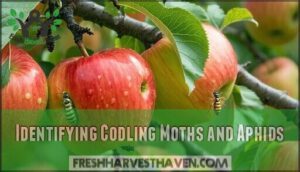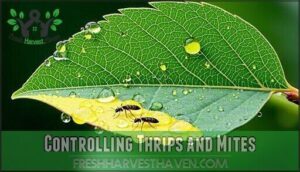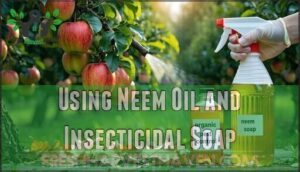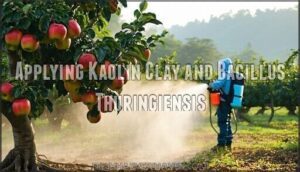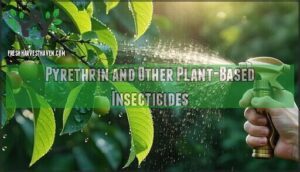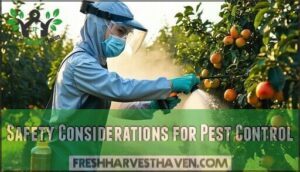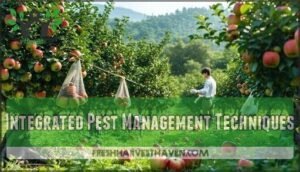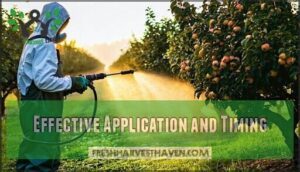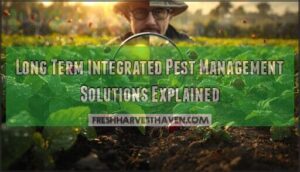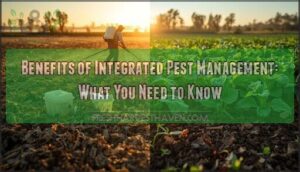This site is supported by our readers. We may earn a commission, at no cost to you, if you purchase through links.
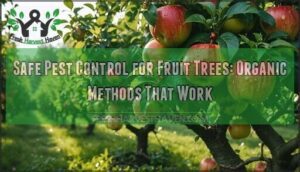
Start by encouraging beneficial insects like ladybugs and lacewings to make your orchard their home – they’ll handle many pests for free.
Companion planting with herbs like basil and marigolds creates natural barriers, while organic sprays using neem oil or insecticidal soap target specific problems without toxicity concerns.
Timing matters too – early spring dormant oil applications and regular monitoring help catch issues before they spiral out of control.
Smart prevention beats reactive treatment every time, and your trees will thank you with healthier, more abundant harvests that won’t leave you wondering what’s really in that apple.
Table Of Contents
- Key Takeaways
- Safe Pest Control Methods
- Common Fruit Tree Pests
- Seasonal Pest Control Strategies
- Organic Pest Control Options
- Safety Considerations for Pest Control
- Integrated Pest Management Techniques
- Effective Application and Timing
- Frequently Asked Questions (FAQs)
- How to keep bugs away from fruit trees?
- Are insecticides safe for fruit trees?
- Can fruit trees be protected from Bugs?
- How do I prevent pests from reaching my fruit?
- How can organic pest control help fruit trees?
- How do I get rid of pests in my fruit trees?
- What is the best pest control for fruit trees?
- What can I spray on my fruit trees for bugs?
- What herbicide is safe around fruit trees?
- What is the best treatment for fruit trees?
- Conclusion
Key Takeaways
- You’ll get better results combining multiple approaches – Use beneficial insects, companion planting, physical barriers, and organic sprays together rather than relying on just one method for comprehensive protection.
- Timing your treatments makes all the difference – Apply dormant oils before bud break, monitor weekly during the growing season, and treat during cool morning or evening hours to maximize effectiveness while protecting pollinators.
- Prevention beats reaction every time – Clean up fallen fruit immediately, maintain proper pruning for air circulation, and encourage beneficial insects like ladybugs to establish themselves before pest problems spiral out of control.
- Natural options work without the risks – Neem oil, insecticidal soap, and Bacillus thuringiensis target specific pests effectively while keeping your harvest safe for your family and preserving the ecosystem balance in your orchard.
Safe Pest Control Methods
You can protect your fruit trees without relying on harsh chemicals that harm the environment and your family’s health.
Natural prevention methods, companion planting, and physical barriers offer effective pest control while keeping your orchard safe for beneficial insects and pollinators.
Natural Pest Prevention Techniques
Prevention trumps treatment when protecting your fruit trees from pests. Start with orchard hygiene by removing fallen fruit immediately, as rotting debris attracts unwanted insects.
Physical barriers and trap cropping create natural defenses that beneficial insects appreciate.
- Install sticky trunk bands – these physical barriers stop crawling pests before they reach branches
- Hang pheromone traps strategically – let fruit tree pests trap themselves while you focus elsewhere
- Maintain clean orchard floors – proper fruit tree care through debris removal eliminates pest breeding grounds
Natural pest control through companion planting and pest prevention strengthens your trees’ defenses effectively.
Sticky barriers are available for effective pest management.
Using Companion Plants for Pest Control
Companion plants create a natural pest control system by attracting predators and repelling pests simultaneously.
You’ll establish ecosystem balance through strategic plant diversity around your fruit trees.
Marigolds and nasturtiums deter aphids while dill and yarrow draw beneficial insects like ladybugs and parasitic wasps.
This ecofriendly solution reduces pest populations by up to 60% while supporting pollinator gardens for thorough pest prevention.
For targeted control, consider using OMRI listed options like insecticidal soap.
Creating Barriers for Pest Control
Building effective defenses starts with understanding your enemy’s tactics. Trunk bands create impenetrable barriers around tree bases, stopping crawling insects before they reach branches. Copper barriers work like nature’s electric fence—slugs and snails won’t cross the metal surface due to chemical reactions with their slime.
You can find specialized trunk bands for sale online.
Think of barriers as your orchard’s security system, working 24/7 without supervision.
Proper timing turns your pest control into a precision strike against unwanted invaders.
Orchard sox expand with growing fruit, providing custom-fitted protection against fruit tree pests. Netting enclosures shield entire sections from flying invaders while allowing air circulation.
Pest traps strategically placed around trees intercept insects at multiple access points. These physical deterrents complement integrated pest management strategies, creating multiple defense layers that protect beneficial insects while stopping harmful ones.
Your pest prevention fortress operates continuously without chemicals.
Common Fruit Tree Pests
You’ll encounter several common pests that can damage your fruit trees, but identifying them early makes control much easier.
The most frequent culprits include codling moths that tunnel into fruit, aphids that cluster on new growth, scale insects that attach to branches, caterpillars that chew leaves, and tiny thrips that cause leaf discoloration.
Identifying Codling Moths and Aphids
Spotting fruit tree pests early prevents costly damage to your harvest. Two major culprits require immediate attention when they appear.
Codling Moth ID starts with recognizing gray adults featuring distinctive copper wing markings. These 12-18mm moths lay eggs on fruit surfaces during spring. Their cream-colored larvae tunnel into apples and pears, leaving characteristic entry holes surrounded by brown frass.
Aphid Identification involves finding tiny, pear-shaped insects clustering on leaf undersides and young shoots.
Here’s your Early Detection checklist:
- Damage Recognition – Look for round holes in fruit with sawdust-like droppings nearby
- Check leaf undersides for small, soft-bodied insects in green, black, or brown colors
- Monitor for sticky honeydew deposits that attract ants to your trees
- Watch for curled, yellowing leaves indicating aphid feeding damage
- Use Pest Monitoring traps during peak flight periods for accurate timing
Understanding Pest Life Cycles helps you time interventions perfectly. Codling moths complete multiple generations yearly, while aphids reproduce rapidly through parthenogenesis. Regular scouting catches these fruit tree pests before populations explode, saving both your sanity and your harvest from these persistent invaders.
Managing Scale Insects and Caterpillars
Your fruit tree’s branches harbor two persistent enemies that threaten its health year-round. Scale insects attach themselves like tiny armored bumps, draining sap through their protective shells and weakening your tree’s natural defenses.
The scale lifecycle makes early detection essential—these pests multiply rapidly once established. Combat them with horticultural oil or dormant oil applications during late winter, which suffocate overwintering adults before they reproduce.
Caterpillars create visible damage through caterpillar defoliation, chewing irregular holes in leaves and fruit. Apply Bt application (Bacillus thuringiensis) specifically targeting these leaf-munchers while preserving natural predators like parasitic wasps.
This biological approach maintains your orchard’s ecosystem balance, allowing beneficial insects to assist in long-term pest management without harmful chemical residues.
Controlling Thrips and Mites
While scale insects weaken branches, thrips and spider mites target leaves and fruit directly.
These microscopic pests puncture plant cells, causing yellowing foliage and fruit deformation that compromises your harvest quality.
Understanding thrip lifecycle helps you time treatments effectively.
Adult thrips lay eggs in leaf tissue, while larvae feed continuously before pupating in soil.
Spider mites reproduce rapidly in warm, dry conditions.
Here’s your targeted approach:
- Deploy mite predators – Release beneficial insects like predatory mites and lacewings for biological control
- Apply acaricide options – Use horticultural oils or insecticidal soaps targeting both pests without harming beneficial insects
- Practice resistance management – Rotate different natural pest control methods to prevent treatment tolerance
Yellow sticky traps catch adult thrips, while regular damage identification through leaf inspection catches infestations early on fruit trees.
Seasonal Pest Control Strategies
Timing your pest control efforts with the seasons gives you the best chance of protecting your fruit trees before problems get out of hand.
Each season brings different pest challenges, so you’ll need to adjust your approach as the year progresses to stay one step ahead of the bugs.
You’ll need to stay vigilant and adapt to these changing challenges to effectively manage pest control throughout the year.
Early Spring Pest Control Measures
Starting before bud break, you’ll want to apply dormant oil or horticultural oil to eliminate overwintering pests and their eggs.
This early application of dormant sprays suffocates hibernating insects when they’re most vulnerable. Early spring application becomes your secret weapon for fruit tree pest prevention.
Install pheromone traps and inspect trees for damage signs. Combine this with strategic tree pruning techniques to remove infected branches and improve air circulation.
These proactive measures create a solid foundation that’ll pay dividends throughout the growing season.
Summer Pest Monitoring and Treatment
Summer heat creates perfect conditions for pest explosions, making vigilant monitoring your best defense against fruit tree damage.
Check your trees weekly for Pest Identification of aphids, spider mites, and other common invaders during the summer months.
Here’s your action plan for effective pest management:
- Scout early morning – You’ll spot Treatment Thresholds before pests overwhelm your trees
- Protect Beneficial Insects – Time your Organic Options carefully to preserve natural predators
- Apply treatments strategically – Use proper Application Timing during cooler hours for maximum effectiveness
Install pheromone traps and sticky bands for continuous surveillance.
When you find problems, act quickly with neem oil or insecticidal soap applications during morning or evening hours to avoid harming pollinators and guarantee better coverage on fruit trees.
Fall and Winter Pest Prevention Techniques
While summer monitoring keeps immediate threats at bay, cooler months offer your best shot at preventing next year’s pest problems before they even begin.
Think of fall and winter as your secret weapon for organic pest control and fruit tree protection.
Dormant spraying becomes incredibly effective when trees enter their sleepy phase.
Late winter applications of horticultural oils smother overwintering eggs and larvae without harming beneficial insects.
Habitat removal through thorough cleanup eliminates pest hideouts—those fallen apples aren’t just unsightly, they’re five-star hotels for codling moths and other troublemakers.
Tree wrapping protects young bark from temperature swings that create perfect entry points for borers.
Meanwhile, winter pruning techniques improve air circulation and remove diseased wood that harbors pests.
Don’t forget soil health—adding compost around your trees strengthens their natural defenses.
- Freedom from summer’s constant vigilance against pest invasions
- Peace of mind knowing you’ve broken destructive pest cycles
- Pride in proactive tree health management that pays dividends
- Satisfaction of working with nature’s dormant rhythms
Organic Pest Control Options
When you’re dealing with fruit tree pests, organic solutions offer effective protection without the risks that come with synthetic chemicals.
These natural methods work by targeting pests directly while keeping your harvest safe for you and your family to enjoy, using natural methods.
Using Neem Oil and Insecticidal Soap
Beyond seasonal strategies, neem oil and insecticidal soap provide effective organic pest control for fruit trees. These safe pesticides target different pests through unique mechanisms.
| Product | Target Pests | Application Method |
|---|---|---|
| Neem Oil | Aphids, scale insects, mites | Foliar spray, soil drench |
| Insecticidal Soap | Soft-bodied insects, mealybugs | Direct contact spray |
| Both | Whiteflies, spider mites | Evening application |
| Neem Oil | Caterpillars, beetles | Growth disruption |
| Insecticidal Soap | Aphids, thrips | Cell membrane disruption |
Neem Oil Benefits include disrupting insect hormones and preventing reproduction. Mix at 0.5-2% concentration for proper Mixing Ratios.
Soap Application Tips require thorough pest coverage since contact kills insects. Apply both during cooler hours following Safety Precautions.
Treatment Frequency depends on pest pressure—typically weekly applications work best. Consider using companion planting benefits for natural pest deterrence.
Applying Kaolin Clay and Bacillus Thuringiensis
Kaolin clay forms a protective white coating that confuses pests and prevents egg-laying on your fruit trees.
Bacillus thuringiensis targets caterpillars specifically through natural toxins that disrupt their digestive systems. Both safe pesticides offer excellent organic compatibility while preserving beneficial insects.
Apply kaolin clay thoroughly using proper spraying techniques, while Bt application timing should target early larval stages for maximum caterpillar specificity in your organic pest control program.
Many gardeners find it helpful to purchase kaolin sprays for easier application.
Pyrethrin and Other Plant-Based Insecticides
Natural warriors from your garden pack serious pest-fighting power.
Pyrethrin from chrysanthemum flowers delivers lightning-fast results against aphids, caterpillars, and flying pests through rapid nervous system disruption.
You’ll appreciate its quick breakdown in sunlight, reducing environmental persistence while maintaining pyrethrin effectiveness.
Combine with essential oils like peppermint for enhanced organic alternatives.
These plant-based insecticides require frequent reapplication but offer superior resistance management compared to synthetics, making them ideal organic pest control choices for sustainable fruit trees.
Safety Considerations for Pest Control
Even the safest organic pest control methods require proper safety measures to protect you and your environment.
You’ll need to wear appropriate protective gear and follow application guidelines to guarantee effective treatment while minimizing risks to beneficial insects and nearby plants, ensuring a safe and effective treatment.
Wearing Protective Gear and Clothing
You’ll need protective gear before applying any pest control treatments.
Slip on chemical-resistant gloves for hand protection, secure eye protection against splashes, and wear a respirator for safe breathing.
Choose long-sleeved clothing made from tightly woven materials that won’t absorb chemicals.
These safety considerations protect you during chemical-free applications and guarantee safe gardening practices throughout your protective routine.
Following Label Instructions and Guidelines
The label on your pest control product isn’t just paperwork—it’s your blueprint for success.
These instructions contain critical Dosage Accuracy information, Application Methods, and Safety Precautions that protect both your trees and family.
- Check dosage rates carefully—more isn’t always better
- Follow timing guidelines for effective pest control effectiveness
- Respect reapplication intervals to prevent resistance buildup
- Store products according to Storage Guidelines away from children
- Consult local guidelines for region-specific regulations and restrictions
Minimizing Chemical Runoff and Environmental Impact
Protecting waterways and beneficial insects requires thoughtful application of eco-friendly solutions that minimize environmental impact.
You can safeguard your local ecosystem while maintaining effective pest control through sustainable farming practices that prioritize soil health and water conservation.
- Apply targeted sprays during calm weather conditions to prevent drift and guarantee chemical-free solutions reach intended areas
- Establish buffer zones around water sources using native plants that filter runoff and protect aquatic environments
- Choose biodegradable options like neem oil that break down naturally without leaving toxic residues in soil
- Use precision application methods to reduce waste and limit chemical exposure to non-target areas
- Implement integrated pest management combining multiple sustainable approaches for thorough, environmentally responsible control
Integrated Pest Management Techniques
You’ll get the best results when you combine multiple pest control strategies instead of relying on just one method.
This integrated approach uses preventive measures like proper pruning and orchard cleanup alongside targeted treatments when pests actually show up.
Combining Preventive Measures and Targeted Treatments
Success in safe pest control for fruit trees comes from blending an Integrated Approach that combines preventive measures with targeted treatments when needed.
This Sustainable Orcharding strategy creates Long-Term Control while protecting Ecosystem Health through Minimal Intervention methods.
You’ll find that pest prevention works best when paired with strategic interventions, creating a balanced system that keeps your fruit trees healthy without overusing treatments.
Prevention Strategy Targeted Treatment Timing
Pruning and Orchard Hygiene for Pest Control
Building on targeted treatment strategies, good pruning techniques and sanitation practices form your defense against orchard pest invasions.
You’ll remove pest hideouts while boosting air circulation and sunlight penetration throughout your trees. Smart pruning during dormancy disrupts pest life cycles, while consistent orchard hygiene eliminates breeding grounds that fuel future infestations.
- Remove diseased branches during late winter to interrupt overwintering pest cycles
- Clear fallen fruit and debris weekly to eliminate pest breeding sites
- Sterilize pruning tools between trees to prevent disease spread
- Dispose of infected plant material away from your orchard to minimize reinfestation
By following these practices, you can effectively manage orchard pests and maintain a healthy orchard ecosystem, ensuring the long-term health of your trees and the overall productivity of your orchard.
Monitoring for Pests and Adjusting Strategies
Weekly pest identification during growing season catches problems early. Check leaves, branches, and fruit for damage signs like holes or discoloration. Use this monitoring data to track pest populations and determine threshold levels for action.
Consider planting umbelliferous flowers to attract beneficial insects.
| Detection Method | Target Pests |
|---|---|
| Sticky traps | Flying insects, aphids |
| Pheromone lures | Codling moths, scale insects |
| Visual inspection | Caterpillars, mites |
Monitor treatment effectiveness after each application, adjusting your adaptive strategies based on results. If pest infestations persist, switch methods to prevent resistance management issues. Smart pest management means staying flexible with your approach.
Effective Application and Timing
You’ll achieve the best pest control results when you choose the right product for your specific pest problem and apply it at the ideal time.
Timing matters more than you might think—early morning or evening applications work better than midday treatments, and catching pests early in their lifecycle saves you time and effort later.
Choosing The Right Insecticide for The Job
When you’re weighing your options between synthetic vs. natural insecticides, you’ll find that natural options offer safer, more sustainable pest control without the drawbacks of synthetic chemicals.
Synthetic insecticides create systemic absorption risks, allowing chemicals to penetrate deep into your fruit trees and potentially cause photosynthesis hindrance while raising food safety concerns.
Natural insecticides work through contact-based application methods, avoiding these complications entirely.
Here’s your toolkit for effective pest management:
- Neem oil – Reduces codling moth populations by 70% without pest resistance development
- Insecticidal soap – Achieves 90% effectiveness against soft-bodied insects like aphids
- Bacillus thuringiensis (Bt) – Delivers 90% success rate against caterpillars naturally
- Kaolin clay – Creates physical barriers reducing insect damage by 50%
- Pyrethrin – Provides fast-acting control with 24-hour breakdown
Always check product labels for proper dosage and timing recommendations.
Effective pest management also includes consistent pest monitoring for early issue detection.
Applying Insecticides at The Right Time
Timing your insecticide applications throughout the year guarantees maximum effectiveness while protecting beneficial insects.
Dormant Spray Timing occurs before bud break when overwintering pests are vulnerable, while Post-Bloom Monitoring helps you catch emerging threats like codling moths.
Temperature Considerations matter—Early Morning Application during cooler hours prevents rapid evaporation and reduces stress on trees.
Pollinator Protection requires avoiding bloom periods when bees are active.
Summer treatments work best during early morning or evening hours when beneficial insects aren’t foraging, maximizing your spray’s impact on target pests.
Season Target Pests Application Timing
Ensuring Proper Dosage and Coverage for Effective Pest Control
Your success with pest control hinges on getting dosage calculation and spray coverage right the first time. When mixing insecticidal soap or other treatments, precise measurements prevent plant damage and guarantee effectiveness. Weather conditions play a vital role—calm mornings offer ideal spray techniques for uniform coverage.
- Mix according to label directions – pest control products work best at recommended concentrations, not stronger doses
- Cover all surfaces thoroughly – undersides of leaves and branch crevices harbor pests that need direct contact treatment
- Time applications properly – insecticide timing during calm weather ensures better coverage and reduces drift to beneficial insects
Equipment calibration matters for coverage uniformity. Your sprayer should deliver consistent droplets across all fruit trees. Check nozzles regularly and adjust pressure for ideal insecticide distribution, ensuring every leaf gets proper protection without waste.
Frequently Asked Questions (FAQs)
How to keep bugs away from fruit trees?
Like knights of old defending their castle, you’ll protect your fruit trees using natural barriers and beneficial allies.
Apply neem oil, encourage ladybugs, use pheromone traps, and maintain clean orchards to keep pests away effectively.
Are insecticides safe for fruit trees?
Insecticides can be safe for fruit trees when you choose the right products and apply them correctly.
Natural options like neem oil and insecticidal soap are safer than synthetic chemicals, which can leave harmful residues on your harvest.
Can fruit trees be protected from Bugs?
Ironically, bugs seem drawn to fruit trees like magnets, but you’ve got plenty of weapons in your arsenal.
Use natural methods like neem oil, beneficial insects, pheromone traps, and companion planting to protect your trees effectively without harsh chemicals, utilizing beneficial insects as part of your strategy.
How do I prevent pests from reaching my fruit?
You’ll protect your fruit by applying dormant oil in early spring, installing pheromone traps, using beneficial insects like ladybugs, and cleaning fallen debris regularly to eliminate pest habitats.
How can organic pest control help fruit trees?
Organic pest control protects your fruit trees naturally without harmful chemicals. You’ll use beneficial insects, neem oil, and companion planting to manage pests while keeping your harvest safe for consumption.
How do I get rid of pests in my fruit trees?
Start early with dormant oil sprays in late winter, then monitor regularly for aphids and codling moths. Use neem oil, insecticidal soap, or beneficial insects like ladybugs for natural control.
What is the best pest control for fruit trees?
Natural insecticides like neem oil and insecticidal soap work best, targeting pests without harming beneficial insects.
Apply dormant oil in early spring, monitor regularly, and use pheromone traps for ongoing protection.
What can I spray on my fruit trees for bugs?
While many worry about harming beneficial insects, you can safely spray neem oil mixed with water, insecticidal soap, or kaolin clay on your fruit trees to control bugs naturally without toxic residues.
This approach allows for a natural method of bug control.
What herbicide is safe around fruit trees?
Choose corn gluten meal as your safest bet – it’s organic, prevents weed seeds from germinating, and doubles as fertilizer.
Apply it early spring before weeds sprout around your trees.
This organic approach, when applied correctly, inhibits root formation in weeds.
What is the best treatment for fruit trees?
Like a shield protecting your orchard’s treasure, you’ll find integrated pest management works best.
Combining dormant oil sprays, beneficial insects, pheromone traps, and organic treatments like neem oil for thorough protection.
Conclusion
Surprisingly, the most effective safe pest control for fruit trees often comes from methods your grandmother might’ve used decades ago.
By combining natural prevention techniques with targeted organic treatments, you’ll create a thriving ecosystem that protects your harvest without compromising your family’s health.
Regular monitoring, beneficial insects, and well-timed applications of organic sprays work together to keep pests at bay.
With patience and consistency, these proven methods deliver abundant, chemical-free fruit you can feel confident serving to those you love.

